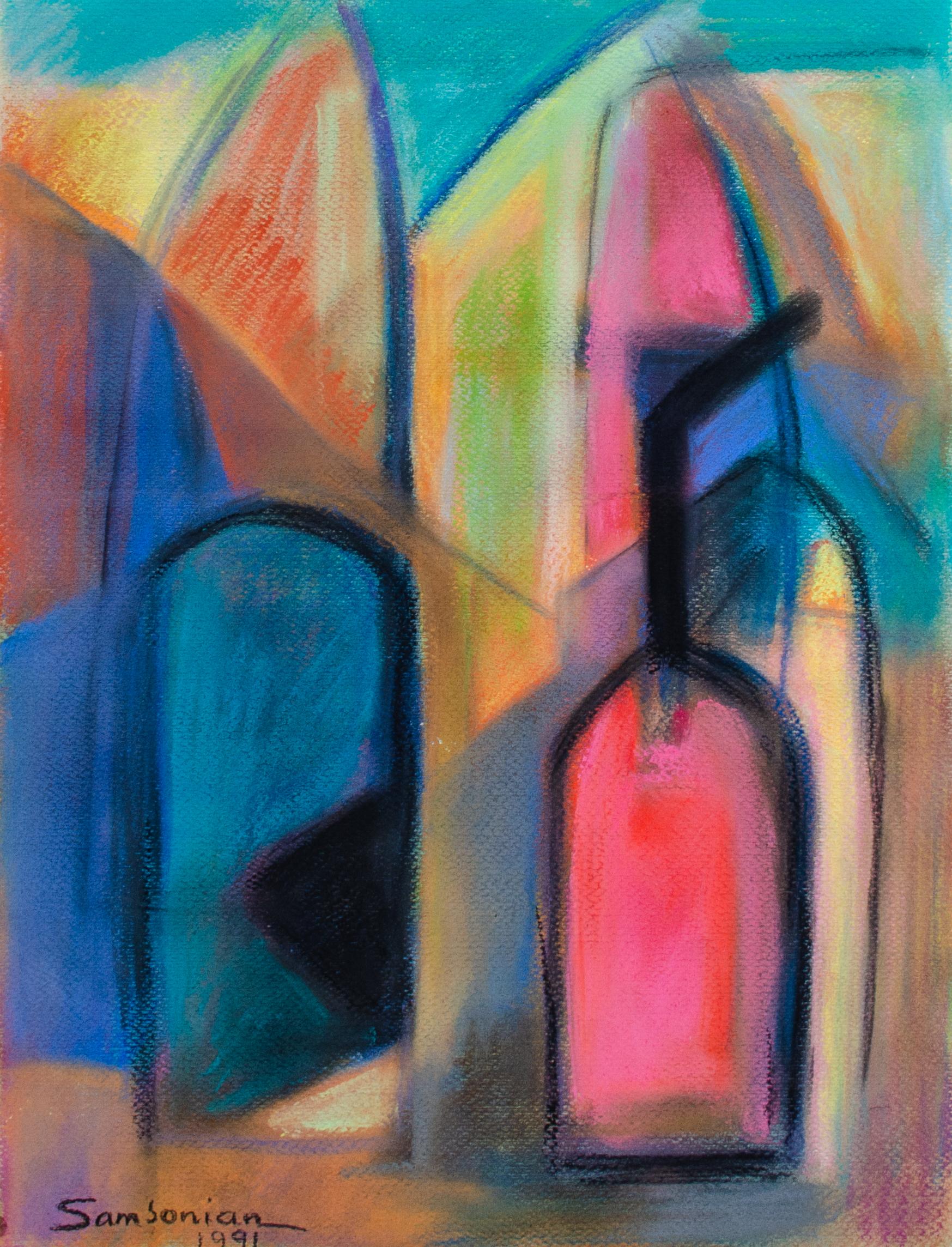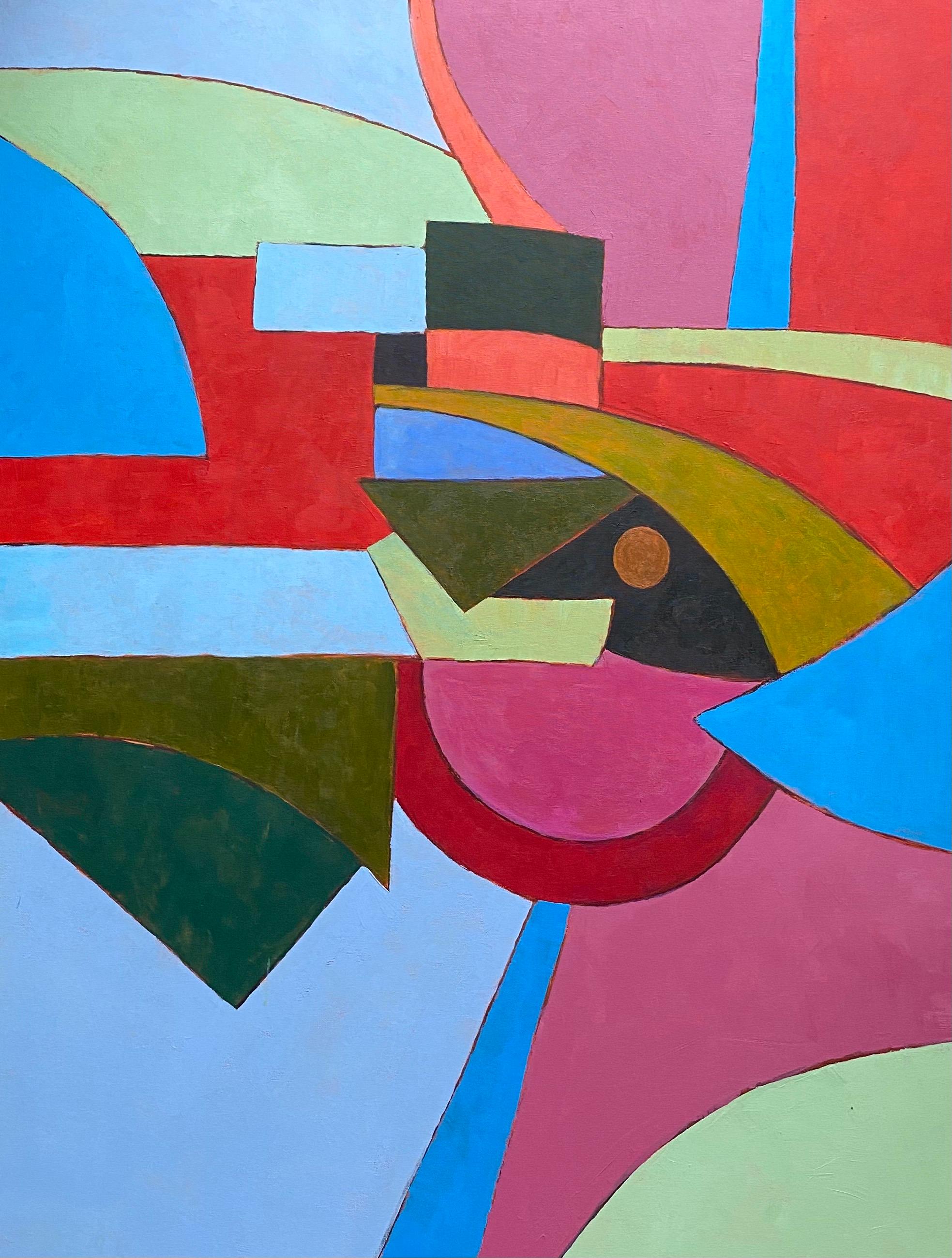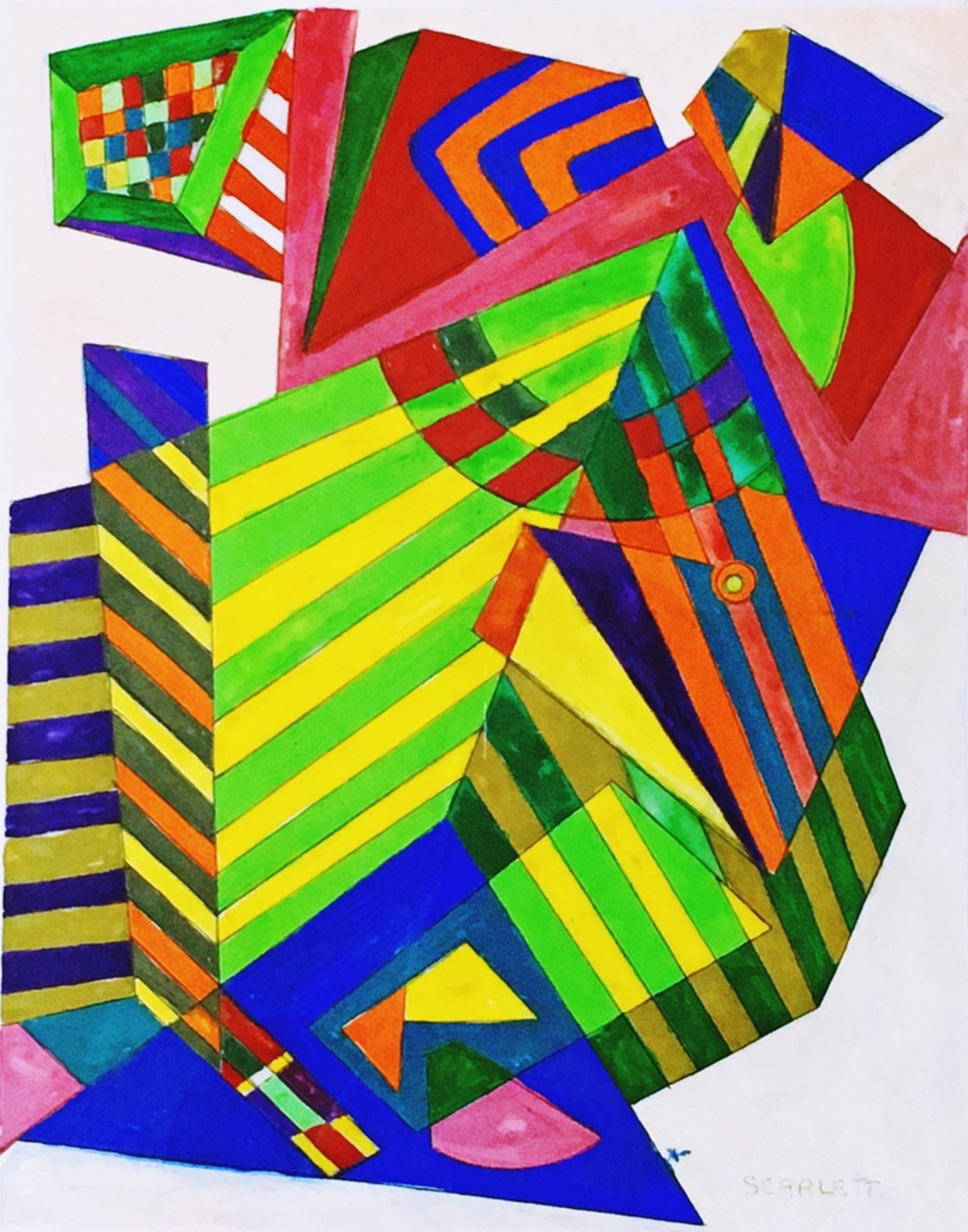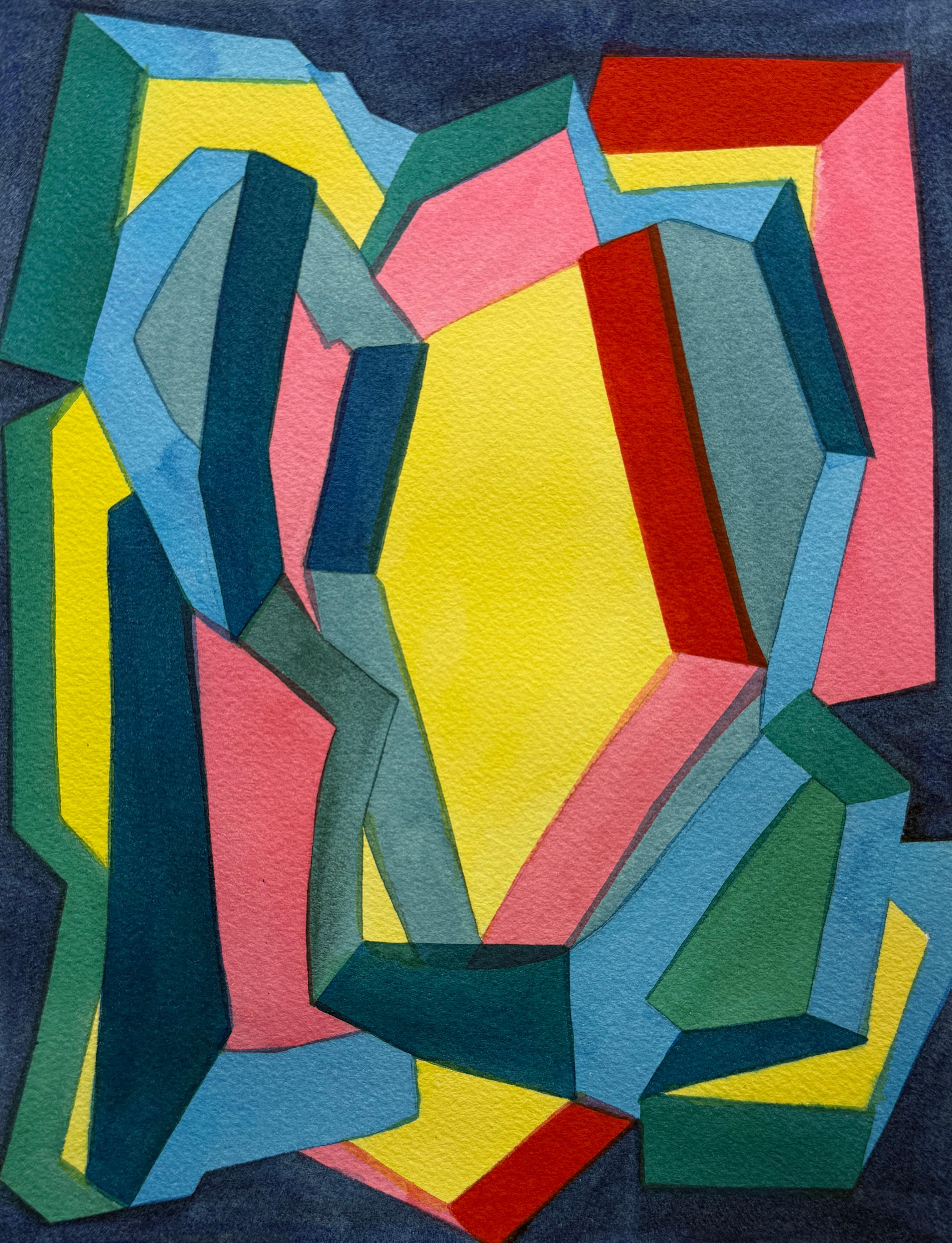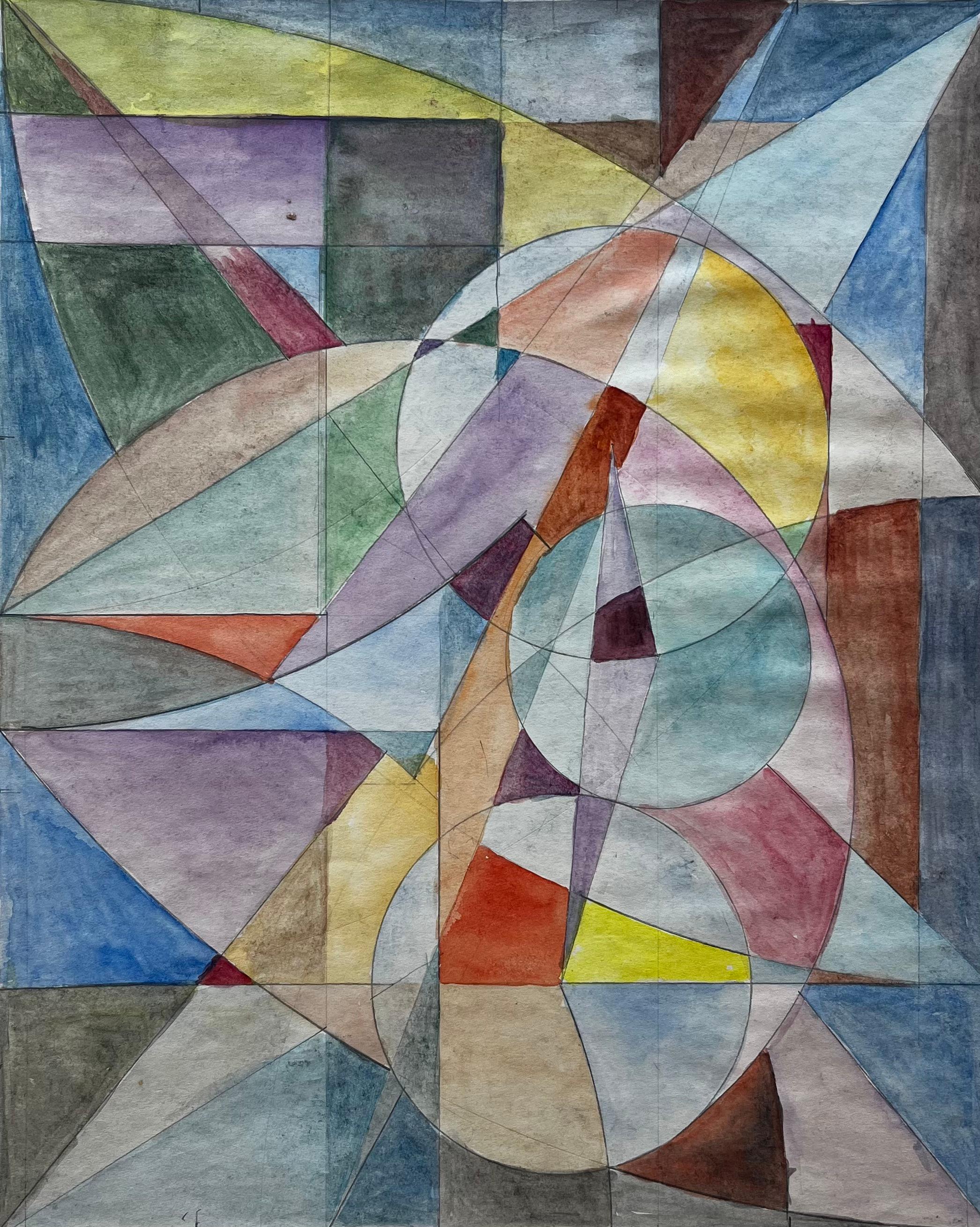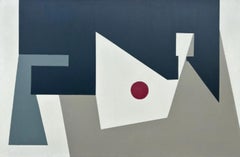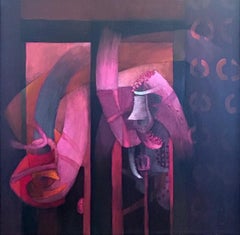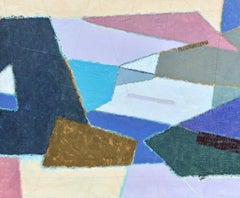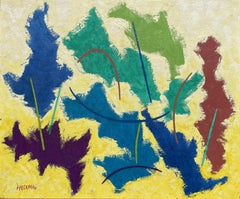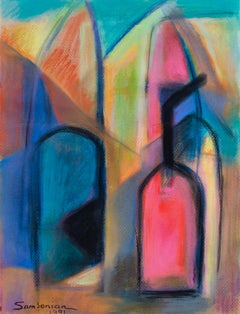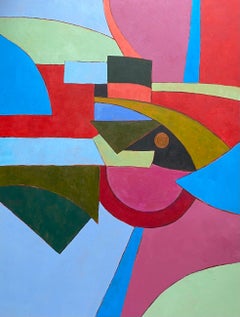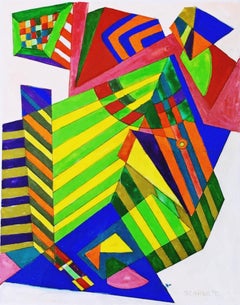Items Similar to "Colorful Geometric Abstraction, " Simon Samsonian, Armenian Artist
Want more images or videos?
Request additional images or videos from the seller
1 of 9
Simon Samsonian"Colorful Geometric Abstraction, " Simon Samsonian, Armenian Artist1981
1981
$3,500
£2,673.66
€3,072.02
CA$5,004.25
A$5,513.52
CHF 2,854.13
MX$66,384.15
NOK 36,140.18
SEK 33,951.41
DKK 22,936.54
About the Item
Simon Samsonian (1912 - 2003)
Colorful Geometric Abstraction, 1981
Oil on paper
16 x 22 inches
Signed and dated lower right
Provenance:
Estate of the artist
This survivor of the Armenian genocide wound up in a Cairo orphanage in 1927. He rose to fame as one of Egypt’s great modernists, but after moving to Long Island late in life he withdrew into anonymity. Now his compelling story is being told. Art historians are finally beginning to realize that the power of abstraction in its early years was a zeitgeist not limited to the major European centers of the avant-garde — Paris, Munich, and Moscow — but one that quickly rippled to major cities throughout the world. Within a few decades that original shock of a new vision had inspired thousands of artists from different cultures — particularly those the Middle East — whose translations were not slavish imitations of works by seminal figures like Picasso, Braque, Malevich, and Kandinsky but creative variants colored by their respective cultures.
This essay focuses on an extraordinary Armenian artist, his harrowing survival of the genocide, his rise to fame in Cairo, and his creation of a unique style of abstraction. Art historians have typically formed a chorus that teaches the history of abstraction like this: Just before and during the World War I era, several avant-garde artists emerged to create shockingly different new forms by which artists could express themselves. In Paris, Picasso and Braque broke out with cubism, quickly followed by Mondrian. In Moscow, Malevich created Suprematism, the ultimate hard-edge geometric abstraction. And in Munich, Kandinsky emerged as the father of Abstract Expressionism. Within these few short years a zeitgeist was sensed throughout the art world. American pioneers, too — particularly Stanton Macdonald-Wright and Morgan Russell — felt this explosive freedom of expression. When Europe was recovering after World War I it became clear that Paris would retain its title as capitol of the art world, lasting through the Roaring Twenties and even through the Great Depression. But the end of World War II changed everything. A parallel war had been won by a group of irascible young Abstract Expressionists in New York — led by Pollock, Rothko, DeKooning, and Kline. No sooner had Paris been liberated from the Germans than Picasso, Matisse, Breton, and Duchamp surrendered to the Americans. From that point on New York would be the epicenter of the art world.
But a lens that focuses myopically on the war between the avant-garde of Paris and New York misses the wider narrative of multiple aesthetic modernities that developed in the several decades following World War I. For Armenian artists the matter is even more complex owing to the genocide of 1915 where more than 1.5 million people — seventy-five percent of Armenians in the Ottoman Empire — were massacred. Those not shot on the spot were sent on death marches through the Mesopotamian desert without food or water. Frequently, the marchers were stripped and forced to walk naked under the scorching sun until they dropped dead.
As a child Samsonian witnessed the murder of his parents and most of the members of his family. Soon thereafter, his older sister, Anahid, quickly shepherded him into a line of children being rescued by Greek nuns. But they became separated and he lost her, too. He was sent to a Greek orphanage in Smyrna (now Izmir), on Turkey’s west coast. Because he only knew his first name, the orphanage gave him a last name based on the place where they found him — Samsun — a major port on Turkey’s north coast on the Black Sea. His birth date was unknown, too. According to Samsonian’s vague recollections he assumed he was about three or four years old at the onset of the genocide, which would place his birth year in 1911 or 1912. In 1922, when Samsonian was about 10, the Turks ended their war with the Greeks by putting Smyrna to the torch in what has been called the “Catastrophe of Smyrna.” Once again, the child was on the run, escaping the fire and slaughter. He found temporary refuge in Constantinople, but within a year that major port would fall to the Turks, too, and become renamed as Istanbul. This time, Samsonian was whisked away to an orphanage in Greece founded by the American charity, Near East Relief — which is credited with saving so many Armenian orphans that the American historian Howard M. Sachar said it “quite literally kept an entire nation alive.
Any understanding of Samsonian’s approach to modernism requires careful consideration of the impact of his early years because his art is inseparable from the anguish he experienced. In 1927, when he was a teenager, he was transferred to Cairo, Egypt, then a cosmopolitan city hosting a sizable portion of the Armenian diaspora. There he lived with thirty-two other children on the top floor of the Kalousdian Armenian School. Upon graduating in 1932 he won a scholarship to attend the Leonardo da Vinci Art Institute — an Italian art school in Cairo — where he won first prize in final examinations among one hundred students. He found work with an Armenian lithographic printer and he returned to the Kalousdian Armenian School to teach drawing. In 1939 he married one of his students, Lucy Guendimian.
The Cairo in which Samsonian matured as an artist was home to many prominent art collectors after World War I. In this receptive environment Samsonian exhibited widely and won many awards. Beginning in 1937 and for the next thirty years he exhibited annually at the prestigious Le Salon du Caire hosted by the Société les Amis de l’Art (founded in 1921). After World War II he hit his stride as a modernist in Cairo, counting among his peers other artists of the Armenian diaspora such as Onnig Avedissian, Achod Zorian, Gregoire Meguerdichian, Hagop Hagopian, and Puzant Godjamanian.
In 1950s Samsonian made extended trips to visit the great art museums of Italy, Paris, and London. The experience proved to be a catalyst for the development of his own style of figurative cubism, boldly structured and colored.
In 1960, nearly a half century after he lost his family he was shocked to discover his sister, Anahid, was living just a few hours to the north in Alexandria. The emotional reunion also revealed his real family name: Klujian.
In 1961 Le Salon du Caire gave Samsonian a solo exhibition of his works created since 1950. It was with great media coverage that for the first time in history an Egyptian Minister of Culture personally opened an exhibition by an Armenian artist. That year, the Salon followed up by sending him on a trip to Paris and London to study contemporary art. Over the years the Salon awarded him seven gold medals at their annual exhibitions.
During the 1960s Anwar Sadat [1918-1981], then President of the National Assembly in Egypt (he became President of Egypt in 1970), acquired a painting by Samsonian and wrote him a letter, commending him as one of the country’s great artists. Samsonian would leave his adopted country in 1968, at the urging of his daughter, and resettled near her in New York. But he first spent two months in Athens where he had been invited to present a solo exhibition. Parnassos, the city’s cultural yearbook, called the exhibition “The best cultural undertaking of the year.”
Samsonian continued painting and drawing, never slowing down. But in this new phase of life he felt he had little more to prove. For decades he had received serious critical recognition and won many awards. Even though an Armenian association published a monograph on him in 1978 his heart was simply not committed to promoting his work through galleries. Samsonian, the painter whose work had become inseparable from his story, slipped away into the quietude of old age and passed away in 2003.
- Creator:Simon Samsonian (1912 - 2003)
- Creation Year:1981
- Dimensions:Height: 24 in (60.96 cm)Width: 30 in (76.2 cm)
- Medium:
- Movement & Style:
- Period:
- Condition:Good condition.
- Gallery Location:New York, NY
- Reference Number:1stDibs: LU184129923672
About the Seller
5.0
Platinum Seller
Premium sellers with a 4.7+ rating and 24-hour response times
Established in 2022
1stDibs seller since 2022
123 sales on 1stDibs
Typical response time: <1 hour
- ShippingRetrieving quote...Shipping from: New York, NY
- Return Policy
Authenticity Guarantee
In the unlikely event there’s an issue with an item’s authenticity, contact us within 1 year for a full refund. DetailsMoney-Back Guarantee
If your item is not as described, is damaged in transit, or does not arrive, contact us within 7 days for a full refund. Details24-Hour Cancellation
You have a 24-hour grace period in which to reconsider your purchase, with no questions asked.Vetted Professional Sellers
Our world-class sellers must adhere to strict standards for service and quality, maintaining the integrity of our listings.Price-Match Guarantee
If you find that a seller listed the same item for a lower price elsewhere, we’ll match it.Trusted Global Delivery
Our best-in-class carrier network provides specialized shipping options worldwide, including custom delivery.More From This Seller
View All"Composition" Balcomb Greene, Geometric Abstract, Early Modernist Composition
By Balcomb Greene
Located in New York, NY
Balcomb Greene
Composition, 1936
Signed Balcomb Greene on verso upper stretcher bar
Signed on backing board: Balcomb Greene
Oil on canvas
30 1/4 x 46 inches
Provenance:
The artist
A...
Category
1930s Abstract Abstract Paintings
Materials
Canvas, Oil
"El Innombrable" Fernando de Szyszlo, Red Mysticist Abstract Composition
By Fernando de Szyszlo
Located in New York, NY
Fernando de Szyszlo
El Innombrable, 1980
Titled inscribed dated verso: Orrentia 1980 "El Innombrable"
Signed lower bottom edge center "Szyszlo"
Oil on canvas
59 1/2 x 59 inches
Fernando de Szyszlo was a Peruvian painter...
Category
1980s Surrealist Abstract Paintings
Materials
Canvas, Oil
"Untitled" James Suzuki, Abstract Color Field Composition, Mid-Century
By James Suzuki
Located in New York, NY
James Suzuki
Untitled, circa 1960
Signed lower right "Suzuki"
Acrylic on canvas
66 1/4 x 80 inches
Provenance:
Private Collection, New Jersey
James Hiroshi Suzuki...
Category
1960s Color-Field Abstract Paintings
Materials
Canvas, Oil
"Untitled" Albert Heckman, Mid-Century American Modernist Abstract Composition
By Albert Heckman
Located in New York, NY
Albert Heckman
Untitled
Signed lower left
Oil on canvas
20 x 24 inches
Albert Heckman was born in Meadville, Western Pennsylvania, 1893. He went to New York City to try his hand at...
Category
1950s Modern Abstract Paintings
Materials
Canvas, Oil
"Abstract Interior of Room" Myron Lechay, Colorful Early Geometric Abstract
By Myron Lechay
Located in New York, NY
Myron Lechay
Abstract Interior of Room, 1923
Signed upper right corner and dated upper left corner
Oil on canvas
24 x 20 inches
Provenance:
Estate of the artist
Spanierman Gallery, ...
Category
1920s Abstract Abstract Paintings
Materials
Canvas, Oil
"Untitled" Seymour Franks, Mid-Century Abstract Swirling Composition
By Seymour Franks
Located in New York, NY
Seymour Franks
Untitled, circa 1948
Signed lower right
Mixed media on panel
15 1/4 x 22 1/2 inches
Seymour Franks, 1916-1981, originated from New York City, where he was born in 19...
Category
1940s Abstract Mixed Media
Materials
Mixed Media, Panel
You May Also Like
Fauvist Pastel by Iranian American modernist Simon Samsonian
Located in New York, NY
Simon Samsonian (1912-2003)
Untitled, 1991
Poster color and pastel on paper
Sight size: 19 1/2 x 14 3/4 in.
Framed: 28 1/4 x 22 1/4 in.
Signed lower le...
Category
1990s Abstract Abstract Drawings and Watercolors
Materials
Paper, Pastel
Geometric Abstract Painting by Listed British artist - Mix of Bright Colors
Located in Cirencester, Gloucestershire
'Abstract Composition'
by Michael Haswell (British, 1931-2020)
inscribed verso
acrylic painting on box canvas (painted edges so do not require framing)...
Category
21st Century and Contemporary Abstract Abstract Paintings
Materials
Canvas, Acrylic
Colorful Abstract painting by Arnold Weber 1968
By Arnold Weber
Located in Long Island City, NY
Artist: Arnold Weber, American (1931 - 2010)
Title: Colorful Abstract
Year: 1968
Medium: Oil on Canvas, Signed, titled and dated l.l.
Size: 32 x 44 in. (81.28 x 111.76 cm)
Category
1960s Abstract Geometric Abstract Paintings
Materials
Oil
Untitled Mid-Century Modern Geometric Abstraction
By Rolph Scarlett
Located in New York, NY
Rolph Scarlett
Untitled Mid-Century Modern Geometric Abstraction, ca. 1950
Gouache on paper painting
Hand signed on lower right front
This is a stunning original, signed vintage 1950...
Category
Mid-20th Century Abstract Geometric Abstract Paintings
Materials
Gouache, Mixed Media, Pencil
Many Wonderful, Colorful Geometric Abstraction with Bold Overlapping Shapes
Located in New York, NY
This vibrant watercolor by Sarah Brenneman features bold, interlocking geometric forms in bright hues of yellow, red, blue, green, and pink, all outlined with a sense of sculptural d...
Category
2010s Abstract Abstract Drawings and Watercolors
Materials
Watercolor, Archival Paper, Pencil
Geometric Abstract Study Colorful Modernist Gouache on Paper
Located in Cirencester, Gloucestershire
Title: Geometric Abstract Study Colorful Modernist Gouache on Paper
Guy Nicod (French 1923 - 2021)
Gouache on artist paper, unframed
Size: 19.25 x 15.75 inches (height x width)
Prov...
Category
Mid-20th Century Modern Landscape Drawings and Watercolors
Materials
Gouache
More Ways To Browse
Geometric Abstraction
Armenian Artists
Oil Paintings Armenian
Fire Escape Used
Stanton Macdonald Wright
M Howard
Greek Smyrna
Hagop Hagopian
Puzant Godjamanian
Vintage Medal
36 X 36 In Painting
Unknown Antique Painting
Used Oil Pastels
Still Life Painting With Flowers
Black And White Figurative Photography
Mid Century Vintage Painting Frames
Beautiful Paintings
Turn Of The Century Painting
